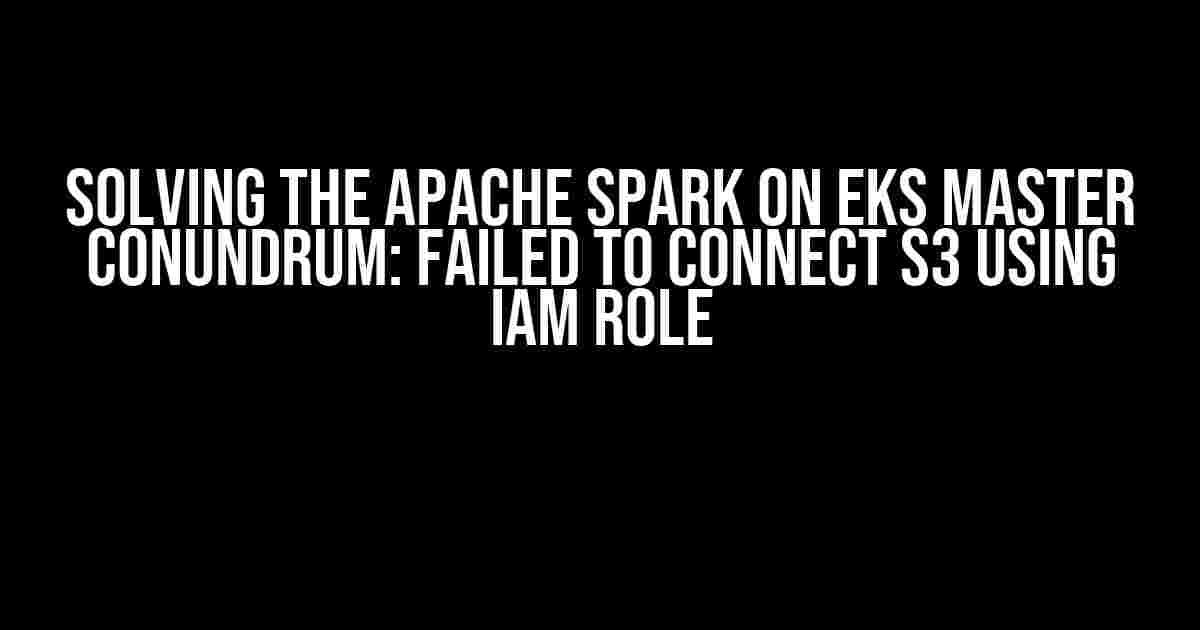Are you tired of banging your head against the wall trying to resolve the pesky issue of Apache Spark on EKS master failing to connect to S3 using an IAM role? You’re not alone! This article is here to guide you through the troubleshooting process, providing clear and direct instructions to get your Spark application up and running with S3 access using IAM roles.
Understanding the Problem
Before we dive into the solution, let’s take a step back and understand the environment and the issue at hand. Apache Spark is a popular open-source data processing engine, and Amazon Elastic Container Service for Kubernetes (EKS) provides a managed Kubernetes service that makes it easy to run Kubernetes on AWS. When running Apache Spark on EKS, you might want to access S3 buckets using an IAM role for authentication. Sounds simple, right? Well, not quite.
The issue arises when the Spark application, running on the EKS master node, fails to connect to S3 using the IAM role. This can be due to a variety of reasons, including misconfigured IAM roles, incorrect Spark configuration, or even network connectivity issues.
The first step in resolving this issue is to ensure that your IAM role is correctly configured. Create a new IAM role or use an existing one that has the necessary permissions to access S3. Here’s a sample policy that should be attached to the IAM role:
{
"Version": "2012-10-17",
"Statement": [
{
"Sid": "AllowS3Access",
"Effect": "Allow",
"Action": [
"s3:GetObject",
"s3:PutObject",
"s3:ListBucket"
],
"Resource": [
"arn:aws:s3:::your-bucket-name",
"arn:aws:s3:::your-bucket-name/*"
]
}
]
}
Make sure to replace “your-bucket-name” with the actual name of your S3 bucket. This policy grants the IAM role access to read and write objects in the specified S3 bucket.
Now that your IAM role is configured, let’s move on to the Spark configuration. Create a new Spark application or modify an existing one to use the IAM role for S3 access. Here’s an example of how to configure Spark using the AWS SDK:
from pyspark.sql import SparkSession
spark = SparkSession.builder \
.appName("Spark S3 Example") \
.getOrCreate()
spark._jsc.hadoopConfiguration().set("fs.s3.impl", "org.apache.hadoop.fs.s3a.S3AFileSystem")
spark._jsc.hadoopConfiguration().set("com.amazonaws.services.s3.enableV4", "true")
spark._jsc.hadoopConfiguration().set("fs.s3.awsAccessKeyId", "YOUR_ACCESS_KEY_ID")
spark._jsc.hadoopConfiguration().set("fs.s3.awsSecretAccessKey", "YOUR_SECRET_ACCESS_KEY")
# Using the IAM role for authentication
spark._jsc.hadoopConfiguration().set("fs.s3a.aws.credentials.provider", "com.amazonaws.auth.InstanceProfileCredentialsProvider")
# Specifying the S3 bucket and object
data = spark.read.format("parquet").load("s3a://your-bucket-name/your-object-key")
Replace “YOUR_ACCESS_KEY_ID” and “YOUR_SECRET_ACCESS_KEY” with your actual AWS access key and secret key, respectively. Make sure to remove these hard-coded values and use a secure method to store and retrieve your AWS credentials.
The last piece of the puzzle is configuring the EKS cluster to use the IAM role for S3 access. You’ll need to create an IAM role for your EKS cluster and attach the necessary permissions to access S3. Here’s an example of how to create an IAM role for your EKS cluster:
Create a new IAM role and attach the following policy:
{
"Version": "2012-10-17",
"Statement": [
{
"Sid": "AllowEKSAccess",
"Effect": "Allow",
"Action": [
"eks:DescribeCluster",
"eks:ListClusters",
"eks:CreateCluster",
"eks:DeleteCluster"
],
"Resource": "*"
},
{
"Sid": "AllowS3Access",
"Effect": "Allow",
"Action": [
"s3:GetObject",
"s3:PutObject",
"s3:ListBucket"
],
"Resource": [
"arn:aws:s3:::your-bucket-name",
"arn:aws:s3:::your-bucket-name/*"
]
}
]
}
Once the IAM role is created, update your EKS cluster to use this role. You can do this by modifying the EKS cluster’s AWS Identity and Access Management (IAM) role ARN.
For example, using the AWS CLI:
aws eks update-cluster-config --name your-eks-cluster-name --region your-region --role-arn arn:aws:iam::123456789012:role/your-eks-cluster-role
If you’re still experiencing issues, here are some troubleshooting tips to help you resolve the problem:
-
Verify that your IAM role has the necessary permissions to access S3. Use the IAM console or the AWS CLI to check the role’s permissions.
-
Check the Spark configuration to ensure that the IAM role is being used for authentication. You can do this by examining the Spark logs or using the Spark UI.
-
Verify that the EKS cluster is using the correct IAM role. Check the EKS cluster’s configuration and ensure that the IAM role ARN is correct.
-
Check the network connectivity between the EKS master node and S3. Ensure that the security groups and network ACLs allow traffic between the master node and S3.
By following these instructions and troubleshooting tips, you should be able to resolve the issue of Apache Spark on EKS master failing to connect to S3 using an IAM role. Remember to configure your IAM role correctly, update your Spark configuration to use the IAM role, and ensure that your EKS cluster is using the correct IAM role. Happy Spark-ing!
| Troubleshooting Step | Solution |
|---|---|
| IAM Role Configuration | Verify IAM role permissions and update the policy to grant access to S3 |
| Spark Configuration | Update Spark configuration to use the IAM role for authentication |
| EKS Cluster Configuration | Update EKS cluster to use the correct IAM role for S3 access |
| Network Connectivity | Verify network connectivity between EKS master node and S3 |
Remember to bookmark this article for future reference, and don’t hesitate to reach out if you have any further questions or concerns. Happy troubleshooting!
-
For more information on Apache Spark, visit the official Apache Spark website.
-
For more information on Amazon EKS, visit the official Amazon EKS website.
-
For more information on AWS IAM roles, visit the official AWS IAM website.
Frequently Asked Questions
Get the answers to the most pressing questions about Apache Spark on EKS master failing to connect to S3 using IAM role.
Q: Why does my Apache Spark on EKS master fail to connect to S3 using IAM role?
This issue often occurs when the IAM role is not properly configured or assigned to the EKS cluster. Make sure the IAM role has the necessary permissions to access S3 and is correctly attached to the EKS cluster. Also, verify that the S3 bucket and IAM role are in the same AWS region.
Q: How do I check if the IAM role is properly configured and assigned to the EKS cluster?
You can check the IAM role configuration by going to the AWS IAM console, navigating to Roles, and verifying that the role has the necessary permissions to access S3. To check if the IAM role is assigned to the EKS cluster, go to the AWS EKS console, select the cluster, and click on “Configuration” to verify that the IAM role is listed under “Instance IAM role”.
Q: What are the necessary permissions required for the IAM role to access S3?
The IAM role requires at least the following permissions to access S3: “s3:GetObject”, “s3:ListBucket”, and “s3:PutObject”. You can attach these permissions to the IAM role by creating a custom policy or using an existing one that includes these permissions.
Q: Can I use an existing IAM role or do I need to create a new one for Apache Spark on EKS?
You can use an existing IAM role, but make sure it has the necessary permissions to access S3. If you’re unsure, it’s recommended to create a new IAM role specifically for Apache Spark on EKS to avoid any potential conflicts or security issues.
Q: Are there any additional steps I need to take to ensure Apache Spark on EKS can connect to S3 using IAM role?
Yes, you need to ensure that the EKS cluster is configured to use the IAM role for service account. You can do this by creating a Kubernetes service account and annotating it with the IAM role. Additionally, you need to configure the Spark application to use the correct S3 bucket and region.



